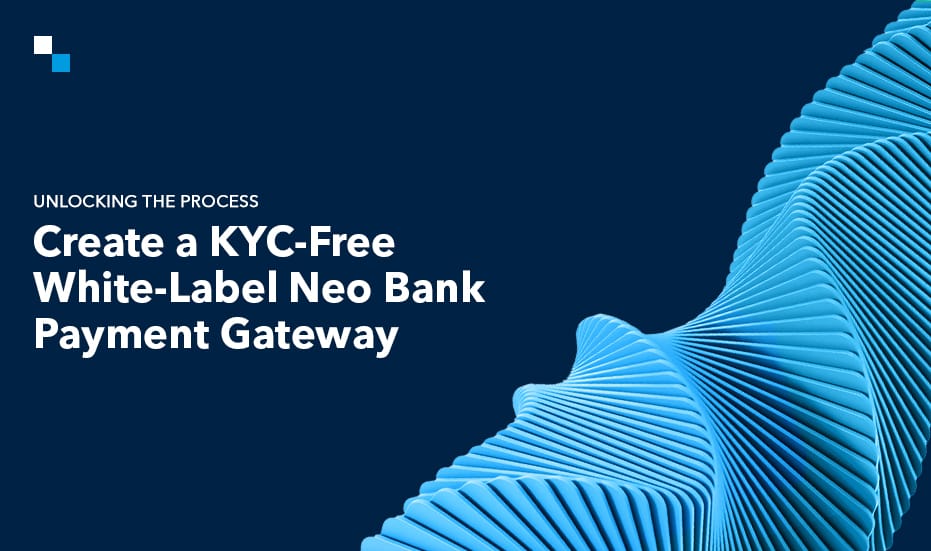
Unlocking the Future of Digital Assets: Tokenized Assets on Public vs. Private Blockchains
November 26, 2024
A Comprehensive Guide to Building dApps on Sui Blockchain
November 26, 2024White-label crypto neo-banks are becoming a major disruptor in the quickly changing financial industry. This innovative model allows businesses to offer branded banking solutions without building infrastructure from scratch. Among its many advancements, creating a payment gateway without KYC has captured attention, catering to users seeking seamless onboarding and privacy in their financial transactions.
This blog explores the features, procedures, and compliance issues needed to develop a white-label neo bank payment gateway without KYC to enable companies to provide quick, secure, and effective payment solutions.
Co-relation of White-Label Neo Bank & Payment Gateways
A white-label neo-banking platform involves partnering with a technology provider to offer pre-built banking services under your brand. This enables businesses to launch customized solutions like digital wallets, virtual cards, and payment gateways.
A white label neo bank payment gateway without KYC is pivotal. It allows users to process transactions anonymously while maintaining a seamless customer experience. These gateways are beautiful in regions with a high demand for privacy or where onboarding challenges restrict access to traditional banking.
Core Features: White-Label Neo Bank Payment Gateway Without KYC
White-label neo-bank payment gateway development without KYC demands a strategic balance between offering privacy and ensuring robust operational and security measures. A thorough and technically sound analysis of the crucial components needed to ensure the success of such a gateway can be found below:
1. Instant User Registration and Onboarding
Without KYC requirements, the onboarding process must be seamless and fast to attract users.
- Technical Implementation: Use self-service portals with minimal user input, relying on device fingerprinting or IP validation for basic verification.
- UX Focus: Simplify the interface for a frictionless experience, ensuring mobile-first compatibility for wider adoption.
2. Multi-Currency Support
The white label neo bank payment gateway must handle multiple currencies, including fiat and cryptocurrencies, to appeal to a global audience.
- Fiat Integration: Leverage APIs to connect with currency exchanges for real-time rates and settlements.
- Crypto Compatibility: Use blockchain technologies like Ethereum or Binance Smart Chain to process decentralized transactions.
- Technical Consideration: Implement dynamic conversion tools for seamless currency swapping during transactions.
3. Decentralized Technology Backbone
Decentralization ensures transparency and trust in non-KYC environments.
- Blockchain Use: Utilize blockchain protocols to store transaction data securely and provide users with immutable records.
- Smart Contracts: Deploy programmable smart contracts for automatic fund transfers and escrow management, reducing manual intervention.
- Transparency: Offer public visibility into transaction records while keeping sensitive data encrypted.
4. Fraud Detection and Risk Management
Without KYC, robust fraud detection mechanisms are essential to mitigate risks.
- AI and ML Integration: Use machine learning algorithms to analyze transaction patterns and flag anomalies in real-time.
- Geofencing: Implement restrictions based on geographic locations prone to fraudulent activities.
- IP and Device Fingerprinting: Identify unique user devices to track behavior and prevent unauthorized access.
5. Customizable Transaction Limits
Introduce dynamic transaction limits to control risks associated with non-KYC users.
- Tiered Limits: Set lower thresholds for non-verified users while offering optional upgrades with minimal verifications.
- Blockchain-Based Limits: Programmatically enforce limits using smart contracts to ensure scalability and adaptability.
6. End-to-End Encryption and Tokenization
Security is paramount in non-KYC white label neo bank payment gateway solutions.
- Encryption Standards: Employ end-to-end encryption using AES-256 standards to safeguard user data during transactions.
- Tokenization: Replace sensitive payment data with unique tokens during processing, minimizing the risk of data breaches.
7. Seamless API-Driven Integration
A white-label neo bank payment gateway must integrate smoothly with third-party applications or existing banking ecosystems.
- RESTful APIs: Offer APIs for simple and flexible integrations across platforms.
- Webhooks and SDKs: Enable real-time notifications and multi-platform functionality for developers.
8. Auditability and Transaction Transparency
Users and businesses must access detailed transaction records to build trust in a non-KYC framework.
- Blockchain Transparency: Store transactions on a public or permissioned blockchain for tamper-proof records.
- Advanced Reporting Tools: Provide dashboards with granular data analytics for businesses to monitor transactions and generate compliance-ready reports.
9. Multi-Factor Authentication and Security Layers
Even in white-label Neo bank payment gateway solutions without KYC, security layers are non-negotiable.
- MFA Implementation: Introduce OTPs, biometrics, or email verifications to ensure secure access.
- Firewalls and Anti-Malware: Use network security tools to prevent unauthorized access or breaches.
10. Scalability and Cloud-Native Architecture
As user demand grows, the gateway must scale efficiently.
- Microservices Architecture: Use microservices to enable modular scaling of specific features like transaction handling or fraud detection.
- Cloud Deployment: To enhance performance and availability, leverage cloud platforms such as AWS, Google Cloud, or Azure.
11. Compliance-Ready Frameworks
Even without KYC, regulatory alignment is critical.
- AML Measures: Include automated transaction monitoring to detect money laundering attempts.
- Regional Adaptations: Design the gateway to comply with local payment processing laws, ensuring long-term sustainability.
The aforementioned features collectively ensure a white-label neo bank payment gateway without KYC is secure and efficient and meets user expectations for privacy and ease of use. Businesses can create novel solutions that appeal to a variety of privacy-conscious customers by combining cutting-edge technologies like artificial intelligence and blockchain with robust security frameworks. However, before investing in white-label neo bank services, businesses must also have an idea of what business benefits they will achieve post-investment.

Business Benefits of White-Label Neo Bank Payment Gateways Without KYC
White-label neo bank payment gateways without KYC bring transformative advantages for businesses in the fintech space. By prioritizing privacy, simplicity, and global accessibility, these solutions unlock a host of technical and strategic benefits. Here is a detailed exploration:-
- Expanded Accessibility to Diverse Markets: Businesses can cater to privacy-conscious users, unbanked populations, and crypto enthusiasts worldwide, bypassing traditional banking restrictions.
- Streamlined User Experience for Higher Retention- Frictionless onboarding processes and privacy-centric operations foster user trust and long-term engagement with the platform.
- Cost Optimization Through Reduced Compliance Burdens- White label crypto neo bank Without KYC requirements, businesses save significantly on compliance infrastructure, manual identity checks, and associated operational expenses.
- Strengthened Market Competitiveness- Offering a KYC-free white label neo bank payment gateway solution positions businesses uniquely in a competitive fintech landscape, making them appealing to niche user segments.
- Effortless Scalability with Modular Frameworks- White-label neo bank gateways support seamless scalability, enabling businesses to expand their operations without additional compliance complexity.
- Faster Revenue Realization Through Quick Deployment- Pre-built white-label crypto neo bank allow businesses to launch rapidly, gaining early market traction and generating revenue sooner.
- Diversified Revenue Channels: Companies can establish several revenue streams by enabling microtransactions, cross-border payments, and premium services.
- Reduced Regulatory Risks in Specific Jurisdictions- Non-KYC gateways are less constrained by regulatory mandates, providing businesses with operational flexibility and fewer legal hurdles.
- Integration of Cutting-Edge Technologies- Businesses can enhance their gateway’s efficiency and security by adopting blockchain for transparent transactions or AI for customer behavior analysis.
- Broadened Industry Applications- Non-KYC payment gateways can serve multiple sectors, including gaming, e-commerce, and decentralized finance, amplifying the business’s market reach.
By leveraging white-label neo bank payment gateways without KYC, businesses can optimize their financial operations, enhance customer experience, and position themselves as innovators in the evolving fintech ecosystem.
10 Simple Steps to Create a White-Label Neo Bank Payment Gateway Without KYC
Creating a white-label Neo Bank payment gateway without KYC is a meticulous process that involves integrating advanced technologies, meeting operational standards, and ensuring seamless user functionality. Here is a detailed walkthrough of the steps to develop such a system, mirroring the practices of leading Neo Bank development companies.
Step 1 : Market Analysis and Feasibility Study
The development begins with an in-depth market analysis to identify the target audience, their preferences, and the demand for non-KYC white label neo bank payment gateways. This includes evaluating existing market players, understanding regulatory constraints, and defining key features. A feasibility study is conducted to assess the technical, financial, and operational aspects of the gateway to ensure viability.
Step 2 : Designing the Gateway Architecture
Once the groundwork is complete, the next step is to design a robust and scalable gateway architecture. This involves creating a blueprint that outlines the core functionalities, such as multi-currency support, transaction processing, and fraud detection mechanisms. A decentralized approach using blockchain technologies is often favored to ensure transparency and security. The architecture must prioritize modularity to allow for future upgrades and integrations.
Step 3 : Backend Development
The main goal of backend development is to construct the payment gateway’s essential features. This includes coding transaction processing systems, database management, and API integrations. Advanced programming languages and frameworks such as Python, Node.js, or GoLang are commonly used to develop secure and high-performance systems. Blockchain integration is implemented during this phase to enable decentralized transaction records and provide trustless operations.
Step 4 : Frontend Development
The user interface is crafted during the front-end development phase. This step ensures that the payment gateway offers a seamless and intuitive experience for users. Developers use responsive design frameworks to create interfaces that work efficiently across devices. Special emphasis is placed on minimizing the steps required to complete transactions, making the gateway appealing to users seeking a fast and hassle-free experience.
Step 5 : Security Implementation
Since the white label neo bank gateway operates without KYC, robust security mechanisms are critical. Developers implement multi-factor authentication, end-to-end encryption, and tokenization to protect user data and transactions. Fraud detection systems powered by machine learning are integrated to monitor real-time activities and flag suspicious behavior. Compliance with PCI DSS standards is ensured to maintain the integrity of the payment infrastructure.
Step 6 : Integration of APIs and Third-Party Services
Third-party services and APIs are incorporated into the system to guarantee interoperability. These include payment processing services for fiat and cryptocurrency transactions, exchange rate providers for real-time currency conversion, and wallet systems for managing user funds. The gateway also integrates blockchain nodes to validate crypto transactions securely.
Step 7 : Testing and Quality Assurance
Once KYC-free white label neo bank development is complete, rigorous testing is conducted to identify and eliminate bugs or vulnerabilities. Functional testing ensures that all features perform as expected, while stress testing evaluates the system’s ability to handle high transaction volumes. Security audits are performed to ensure the gateway can withstand potential cyber threats. Testing also includes evaluating the user interface for any usability issues.
Step 8 : Deployment and Launch
After successful testing, the gateway is deployed on a cloud-based infrastructure for maximum scalability and reliability. Leading platforms like AWS, Google Cloud, or Azure are typically chosen for hosting. A soft launch is conducted to gather user feedback and make any necessary adjustments before the official release.
Step 9 : Post-Launch Maintenance and Upgrades
Once the white label neo bank payment gateway is live, continuous monitoring and maintenance are performed to ensure smooth operations. Performance metrics are analyzed to identify areas for improvement. Regular updates are rolled out to enhance features, fix vulnerabilities, and adapt to changing market demands. The modular architecture simplifies adding new features, such as advanced analytics or additional currency support, as the business evolves.
Step 10 : User Support and Feedback Integration
A dedicated support system is established to assist users with any queries or issues. Feedback mechanisms are integrated into the gateway to collect user insights, which are used to refine the platform. Businesses prioritize user satisfaction to build trust and loyalty, ensuring the long-term success of the gateway.
Businesses can create a white-label neo bank payment gateway without KYC that satisfies consumer demands, maintains security, and provides outstanding user experiences by following these painstakingly designed steps. The best thing that businesses can do is that they can partner with a world-class crypto neo bank development company that holds immense expertise and experience in designing and delivering impactful solutions for your business. Also, apart from this, the blockchain developers of the renowned company can help you stay updated with the latest trends and features that are incorporated in your project.
Future Nexus of KYC-Free White Label Neo Banl Pyament Gateway
The future nexus of white-label neo bank payment gateway without KYC lies in their transformative potential across the evolving financial landscape, particularly within the realms of DeFi, Web3, and beyond into Web4. As we have evidently read in the benefit section, these gateways facilitate borderless, frictionless, and permissionless transactions, which are in perfect harmony with the principles of decentralized finance.
In the Web3 space, such solutions will play a pivotal role in decentralizing identity management and enabling self-sovereign data control, enhancing user autonomy. As Web4 emerges, characterized by seamless integration of AI, IoT, and blockchain, these gateways are poised to act as critical nodes for autonomous machine-to-machine payments, revolutionizing industries from e-commerce to supply chain management. The convergence of privacy, technology, and decentralized principles positions them as a cornerstone of the next-generation financial ecosystem.
Why Invest In Antier’s White Label Neo Bank Payment Gateway?
Financial institutions must invest in robust and feature-rich White-Label Neo Bank Payment Gateway without KYC to capitalize on the burgeoning crypto and Defi markets. Our cutting-edge solution empowers you to launch your own branded banking services, offering seamless and secure payment experiences to your customers.
Are you ready to invest in professional white label neo bank development services? If yes, then collaborating with Antier is a strategic move and approach for your business. Our seasoned blockchain developers guide you through every step of the development process, ensuring a robust and efficient solution. As a leading crypto neeo bank development company, we offer a range of services, including:
- Custom white-label neo bank development
- Integration with blockchain networks
- Secure wallet solutions
- Robust payment gateways
- Advanced security features



